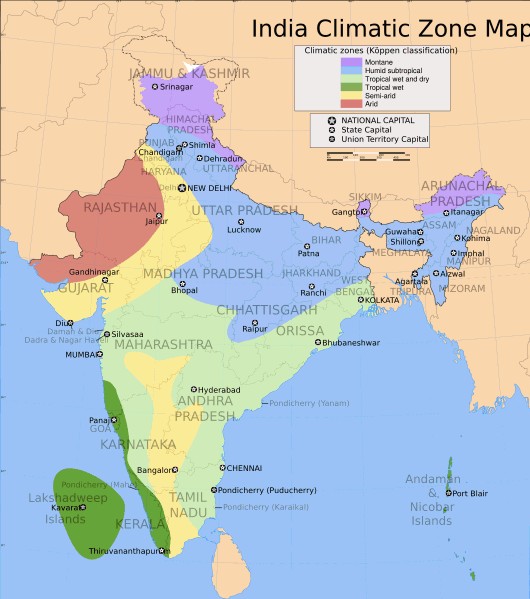The
climate in India is dominated by the seasonal monsoon, but regional
differences in the micro-climate abound due to the varying topography and
the influence of the oceans. Indeed, the presence of the Himalayas and the
Indian Ocean lend the country characteristics of both a tropical climate and
a continental one. The result is an extreme in temperature and moisture
levels from the arid conditions of the Thar Desert to the rainforest climate
of the Northeastern States. Similarly, temperatures vary from below freezing
in the higher passes of the Himalayas to torrid heat on the Gangetic Plains.
It is therefore difficult to generalize about the climate in India as a
whole. Nevertheless, India does provide one of the best examples of a
monsoon climate due to the distinct division between the wet and dry
seasons.
The monsoon in India arises from the
reversal of the prevailing wind direction from Southwest to Northeast and
results in three distinct seasons during the course of the year. The
Southwest monsoon brings heavy rains over most of the country between June
and October, and is referred to commonly as the ‘wet’ season. Moisture laden
winds sweep in from the Indian Ocean as low-pressure areas develop over the
subcontinent and release their moisture in the form of heavy rainfall. Most
of the annual rainfall in India comes at this time with the exception of in
Tamil Nadu, which receives over half of its rain during the Northeast
monsoon from October to November.


(www.wikimedia.org)
The retreating monsoon brings relatively cool and dry weather to most of
India as drier air from the Asian interior flows over the subcontinent. From
November until February, temperatures remain cool and precipitation low. In
northern India it can become quite cold, with snow occurring in the
Himalayas as weak cyclonic storms from the west settle over the mountains.
Between March and June, the temperature and humidity begin to rise steadily
in anticipation of the Southwest monsoon. This pre-monsoonal period is often
seen as a third distinct season although the post-monsoon in October also
presents unique characteristics in the form of slightly cooler temperatures
and occasional light drizzling rain. These transitional periods are also
associated with the arrival of cyclonic tropical storms that batter the
coastal areas of India with high winds, intense rain and wave activity.
As mentioned, rainfall and temperature
vary greatly depending on season and geographic location and even within
these, the timing and intensity of the monsoon is notoriously capricious.
The result is a vastly unequal and unpredictable distribution over time and
space. In general, the northern half of the subcontinent sees greater
extremes in temperature and rainfall with the former decreasing towards the
north and the latter towards the west. Rainfall in the Thar Desert and areas
of Rajasthan can be as low as 200mm per year, whereas on the Shillong
Plateau in the Northeast, average annual rainfall can exceed 10,000 mm per
year. Similarly, temperatures vary from sub-zero in altitude during the
winter months to 48C highs in mid-summer. On average, the mean maximum
temperature during the coolest months in northern India is 21C and during
the summer months between 38-43C. The extreme southern portion of the
country sees less variation in temperature and rainfall. In Kerala, the
temperature varies by only 2.5C around the annual mean of 27C and the total
annual rainfall is 3,000 mm.